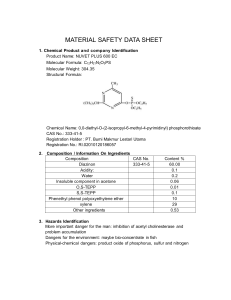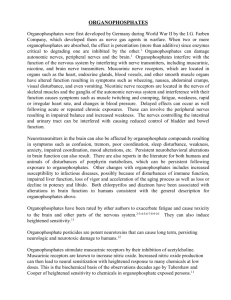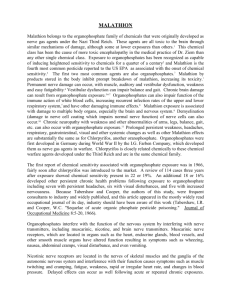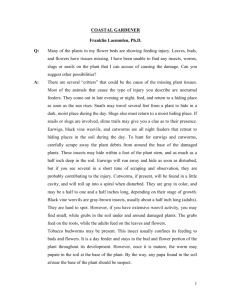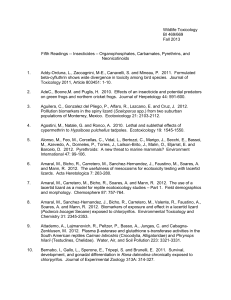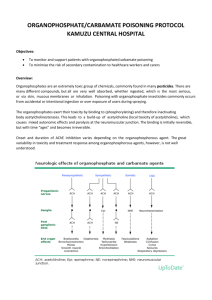Diazinon Website
advertisement
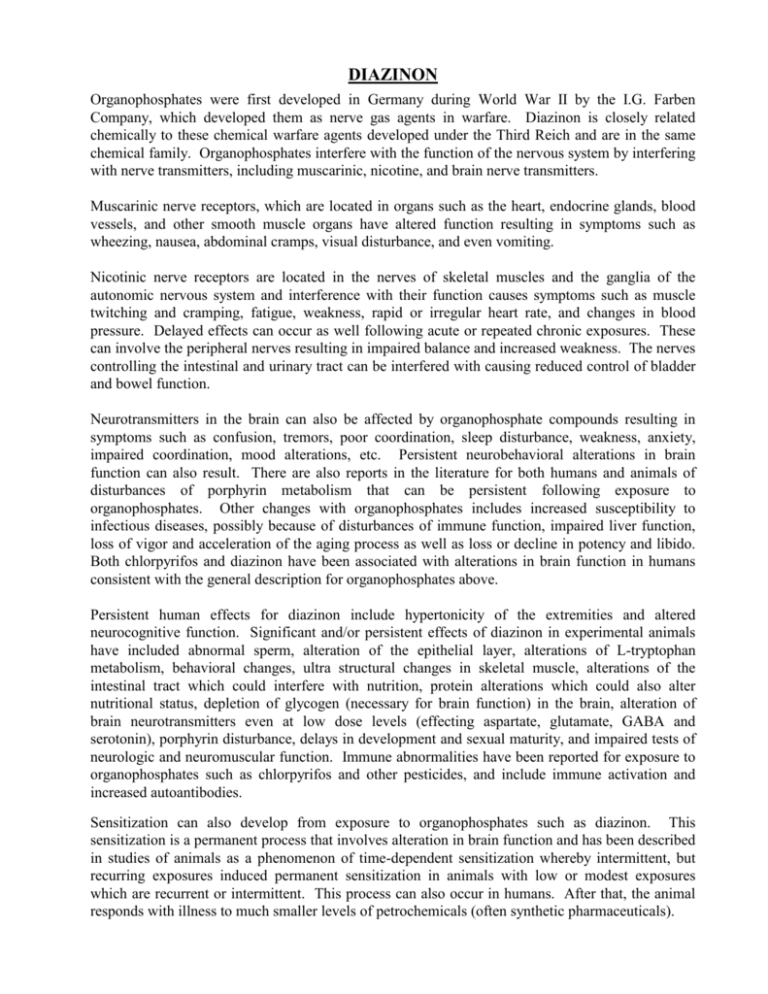
DIAZINON Organophosphates were first developed in Germany during World War II by the I.G. Farben Company, which developed them as nerve gas agents in warfare. Diazinon is closely related chemically to these chemical warfare agents developed under the Third Reich and are in the same chemical family. Organophosphates interfere with the function of the nervous system by interfering with nerve transmitters, including muscarinic, nicotine, and brain nerve transmitters. Muscarinic nerve receptors, which are located in organs such as the heart, endocrine glands, blood vessels, and other smooth muscle organs have altered function resulting in symptoms such as wheezing, nausea, abdominal cramps, visual disturbance, and even vomiting. Nicotinic nerve receptors are located in the nerves of skeletal muscles and the ganglia of the autonomic nervous system and interference with their function causes symptoms such as muscle twitching and cramping, fatigue, weakness, rapid or irregular heart rate, and changes in blood pressure. Delayed effects can occur as well following acute or repeated chronic exposures. These can involve the peripheral nerves resulting in impaired balance and increased weakness. The nerves controlling the intestinal and urinary tract can be interfered with causing reduced control of bladder and bowel function. Neurotransmitters in the brain can also be affected by organophosphate compounds resulting in symptoms such as confusion, tremors, poor coordination, sleep disturbance, weakness, anxiety, impaired coordination, mood alterations, etc. Persistent neurobehavioral alterations in brain function can also result. There are also reports in the literature for both humans and animals of disturbances of porphyrin metabolism that can be persistent following exposure to organophosphates. Other changes with organophosphates includes increased susceptibility to infectious diseases, possibly because of disturbances of immune function, impaired liver function, loss of vigor and acceleration of the aging process as well as loss or decline in potency and libido. Both chlorpyrifos and diazinon have been associated with alterations in brain function in humans consistent with the general description for organophosphates above. Persistent human effects for diazinon include hypertonicity of the extremities and altered neurocognitive function. Significant and/or persistent effects of diazinon in experimental animals have included abnormal sperm, alteration of the epithelial layer, alterations of L-tryptophan metabolism, behavioral changes, ultra structural changes in skeletal muscle, alterations of the intestinal tract which could interfere with nutrition, protein alterations which could also alter nutritional status, depletion of glycogen (necessary for brain function) in the brain, alteration of brain neurotransmitters even at low dose levels (effecting aspartate, glutamate, GABA and serotonin), porphyrin disturbance, delays in development and sexual maturity, and impaired tests of neurologic and neuromuscular function. Immune abnormalities have been reported for exposure to organophosphates such as chlorpyrifos and other pesticides, and include immune activation and increased autoantibodies. Sensitization can also develop from exposure to organophosphates such as diazinon. This sensitization is a permanent process that involves alteration in brain function and has been described in studies of animals as a phenomenon of time-dependent sensitization whereby intermittent, but recurring exposures induced permanent sensitization in animals with low or modest exposures which are recurrent or intermittent. This process can also occur in humans. After that, the animal responds with illness to much smaller levels of petrochemicals (often synthetic pharmaceuticals). Re: Diazinon Page 2 Of 114 persons suffering from organophosphate exposure in a 1966 study, 22 developed chemical sensitivity. A 1995 study found that 14 of 36 patients exposed to chlorphyrifos developed multiple chemical sensitivity. The National Pesticide Telecommunication Network has collected data on incoming calls involving pesticide overexposure and has reviewed these for the presence of chemical sensitivity. During the years between 1984 and 1991, 158 calls indicated symptoms of chemical sensitivity following exposure to chlorphyrifos and 148 following exposure to diazinon, both organophosphates. Dr. Ziem has multiple patients whose chemical injury (involving chronic brain, neurologic, respiratory and other damage) developed following exposure to diazinon. Thus, chronic health effects involving multiple organ systems can arise following exposure to diazinon or chlorpyrifos. One of these effects is chemical injury, but many other serious effects occur as well as described above. Patients with neurologic damage and neural sensitization have brain injury with neural sensitization, heightened sensitivity to a wide variety of petrochemicals accompanied by chronic illness involving multiple organ systems. There is typically impairment of brain function on neurocognitive testing, altered immune function typically involving increased activation, increased autoantibodies, and/or impaired T, B, and/or natural killer cell function, and the condition typically develops during and following symptomatic pesticide or other petrochemical exposure. The following are abnormalities seen in my chemically injured organophosphate poisoned patients. Intestinal abnormalities are common and often involve impaired immunity of the gut (impaired secretory IgA), impaired intestinal digestive enzymes, and increased pathogens probably due to impaired immune function. Respiratory abnormalities are also common, due to the mechanism of neurogenic inflammation in which neurologic abnormalities initiate and perpetuate a chronic inflammatory state of heightened sensitivity of the respiratory tract resulting in chronic sinus, nasal, and bronchial problems, and increased asthma. The alterations of the intestinal tract as well as chemical injury to a wide number of body organs results in excessive utilization of nutrients and impaired function of nutrients, resulting in a wide range of nutritional deficiencies which need to be treated. Liver function abnormalities also occur and often involve an imbalance between the Phase I and Phase II steps of detoxification such that the unstable molecules produced by Phase I are not able to be rapidly detoxified by Phase II, and these unstable molecules (free radicals) attack cell membranes, body proteins, and cause a wide range of chemical injuries. These can result in disturbed enzyme function as well as a wide range of other disturbances. To attribute chemical injury to a particular exposure in our practice we require that symptoms develop during the exposure or not longer than a few days following the exposure, that symptoms improve when removed from exposure, that symptoms recur with return to exposure, and that symptoms again are reduced with removal from exposure. Symptoms must also be present which are consistent with those associated with the chemical or chemical family. In theory, chemical sensitivity can also be diagnosed or confirmed by challenge testing. At this time, the state of the science for challenge testing of chemically sensitive patients is such that this type of testing cannot be guaranteed to be either sensitive or safe. We do not presently have Re: Diazinon Page 3 sufficient information to know what levels of exposure for various chemicals are adequate to cause response in a chemically sensitive person, but not in a non-sensitive person, nor what levels are safe and will not result persisting or long-lasting aggravation of symptoms. In our practice, we utilize a range of laboratory tests to confirm a pattern of chemical injury and we do not diagnose multiple chemical sensitivity without laboratory testing, which in our experience is consistent in its results with that which we see in other chemically sensitive patients. I have been asked to explain the difference between my medical approach and that of clinical ecologists. I am an occupational medicine physician and have developed my practice utilizing conventional occupational medicine approaches evaluating exposures and conducting a comprehensive history of exposure. While clinical ecologists often take some history of exposure, their lack of training in the areas of occupational medicine, toxicology, and industrial hygiene lead to less comprehensive exposure histories and less skill in identifying and correcting chemical factors. This deficiency is widespread in main-stream medicine as well. With rare exceptions, I do not read the clinically ecology literature and, even in the rare exceptions, I do not rely on this literature unless I have independently verified the information. Many clinical ecologists utilize a treatment known as provocation neutralization "therapy" in which small doses of chemicals are administered to the patient at low doses, possibly homeopathic low doses, as an ongoing form of "treatment." My understanding of toxicology suggests that this is toxicologic nonsense when used as ongoing therapy. Clinical ecologists as a group seem to utilize nutritional therapies too commonly when they have not documented deficiencies of the specific nutrients in question. While they may have clinical experience with this approach, my approach is to first document deficiencies and treat documented deficiencies. In my experience, patients with chemical sensitivity can differ significantly between each other in terms of which specific nutrients are effected. Many clinical ecologists currently lack sufficient epidemiologic expertise to recognize limitations in their research and the research of others (a critique which also applies to most mainstream physicians). References: Steenland, K. etal. "Chronic neurological sequelae to organophosphate poisoning," American Journal of Public Health 84:731-736, 1994. Kaplan, J. etal. "Sensory neuropathy associated with Dursban (chlorpyrifos) exposure," Neurology 43:2193-2196, 1993. Delayed toxic effects of chemical warfare agents. Stockholm International Peace Research Institute, Monograph, Stockholm, Sweden, 1975. Thrasher, J. etal. "Immunologic abnormalities in human exposed to chlorpyrifos: preliminary observations," Archives of Environmental Health 48:89-93, 1993. Tabershaw, I. and Cooper, W. "Sequelae of acute organic phosphate pesticide poisoning," Journal of Occupational Medicine 8:5-20, 1966. Sherman, J. Toxicology and Industrial Health 11:33-39, 1995. Sorg, B. etal. "Neuroanatomy and neurochemical mechanisms of time-dependent sensitization," Toxicology and Industrial Health 10:369-386, 1994. Re: Diazinon Page 4 Broughton, A. etal. "Chronic health effects and immunologic alterations associated with exposure to pesticides," Comments-Toxicology 4:59-71, 1990. Stalberg, E. etal. "Effect of occupational exposure to organophosphorus insecticides on neuromuscular function," Scandinavian Journal of Work Environment and Health 4:255-261, 1978. Callender, T. etal. "Evaluation of chronic neurological sequelae after acute pesticide exposure using SPECT brain scan," Journal of Toxicology and Environmental Health 41:275-284, 1994. Rosenstock, L. etal. "Chronic central nervous system effects of acute organophosphate pesticide intoxication," The Lancet 338:223-227, 1991. Savage, E. "Chronic neurological sequelae of acute organophosphate pesticide poisoning," Archives of Environmental Health 43:38-45, 1988. Senanayake, N. and Karalliedde, L. "Neurotoxic effects of organophosphorous insecticides," New England Journal of Medicine 316:761-63, 1987. Ernest, K. etal. "Delayed effects of exposure to organophosphorus compounds," Indian Journal of Medical Research 101:81-84, 1995. Sherman, J. Chemical Exposure and Disease: Diagnostic and Investigative Techniques, Princeton Scientific Publishing Company, Princeton, NJ, 1994. Wagner, S. and Orwick, D. "Chronic organophosphate exposure associated with transient hypertonia in an infant" Pediatrics 1:94-7, 1994. Richter, E. etal. "Illness and excretion of organophosphate metabolites four months after household pest extermination," Archives of Environmental Health 47:135-8, 1992. Kurt, T. "Persistent symptoms of cholinesterase inhibiting pesticide toxicity (diazinon)," Toxicology p. 268, 1988. Veterinary and Human Alam, M. and Maughan, O. "The effect of malathion, diazinon, and various concentrations of zinc, copper, nickel, lead, iron, and mercury on fish," Biological Trace Element Research, September 1992, pp 225-36. Sakr, S. etal. "Effect of diazinon on freeze, fracture images of microvilli of intestinal epithelial cells of Tilapia nilotica," Z Ernahrungswiss, December 1991, pp 268-75. Ansari, B. and Kumar, K. "Diazinon toxicity.........," Science of the Total Environment 76:63-8, 1988. Matin, M. etal. "Effect of adrenalectomy on diazinon-induced changes in carbohydrate metabolism," Archives of Toxicology 63:376-80, 1989. Rajendra, W. etal. "Effects of chronic intake of diazinon on blood and brain monoamines and amino acids," Drug and Chemical Toxicology 9:117-31, 1986. Bleakley, P. etal. "Diazinon and porphyria cutanea tarda," Medical Journal of Australia 21:314-5, 1979. Spyker, J. and Avery, D. "Neurobehavorial effects of prenatal exposure to the organophosphate diazinon in mice," Journal of Toxicology and Environmental Health December 1977, pp 989-1002.
